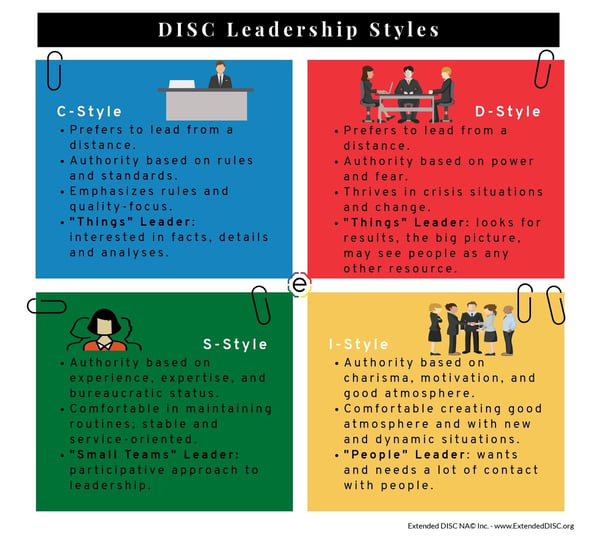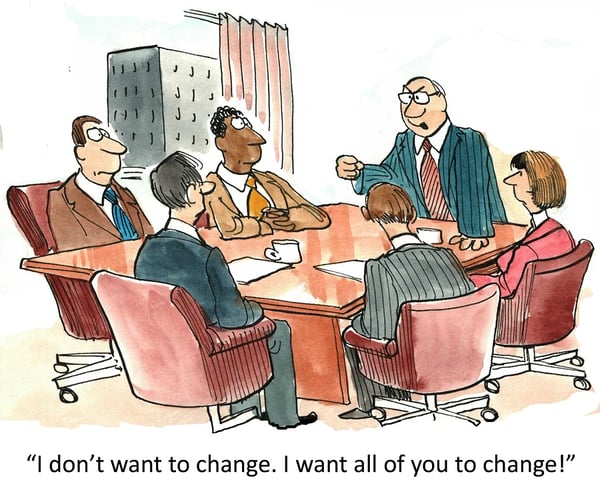How you lead is closely tied to your behavioral style(s). Successful leadership comes in all styles; each has strengths and each has areas of development. There is no one best style for a leader; every one of us can further develop our skills as a leader.
 Leaders are deemed successful, in large part, by how well they interact with their employees. Leaders, as with anyone, can only control their own behaviors; they cannot force others to modify their behaviors.
Leaders are deemed successful, in large part, by how well they interact with their employees. Leaders, as with anyone, can only control their own behaviors; they cannot force others to modify their behaviors.
Leaders, like all of us, need to follow the 4-step process. First, they need to recognize the differences and similarities in the styles of their employees. Next, leaders need to recognize their own leadership style and how others perceive them. Finally, they need to identify the styles of their employees, in order to make adjustments to their own style, to improve the interactions.
Leaders constantly face dynamic situations where they are pressured to adapt. They are usually juggling many roles. The only true blueprint for success as a leader is to have a strong sense of self-awareness and the ability to modify style(s) appropriately. The most successful leaders are the ones who recognize when something isn't working and make adjustments, while those who don't make adjustments are prone to failure.

D-style leaders
Leadership belongs to those who take it.
Sheryl Sandberg, COO Facebook
D-styles tend to be decisive, independent, and competitive leaders who are looking to seize opportunities. They are "large and in charge" who prefer leading from a distance and from a position of authority. They look for speedy execution and results; targeting short-term, but far reaching goals with immediate impact. D-styles are risk takers and prone to think "outside the box". They thrive in crises and challenging situations where they take command.
It's not enough that we win; all others must lose.
Larry Ellison, former CEO of Oracle
D-styles can be intimidating and abrasive to others. They are not going to ask for input and can come across as insensitive. D-style leaders tend to see their employees as any other resource. Employees may feel highly pressured from their D-style leader's quest to finish short-term goals quickly and keep moving forward. The risks may not always equal the reward; mistakes may be made.
Leadership is solving problems. The day soldiers stop bringing you their problems is the day you have stopped leading them. They have either lost confidence that you can help or concluded you do not care. Either case is a failure of leadership.
Colin Powell
For the D-style leader, practice slowing down the pace, building rapport, listening more, and not dominating the interaction. They should consider making decisions with input from others and take the time to do things right the first time. This may be uncomfortable without practice, but will ultimately be a more efficient way to accomplish goals and garner more respect as a leader.
I-style leaders
Communication is the most important skill any leader can possess.
Richard Branson, Founder of Virgin Group
I-styles are charismatic "people" leaders who focus on creating positive work environments. They are motivating and positive leaders who are comfortable communicating informally. I-style leaders are energetic and creative. They use their ability to influence others over the use of pressure. I-style leaders have the natural ability to align everyone together to accomplish goals. Their team culture is, on the average, more open and people-oriented.
I’ve learned to fight all my life – gotta keep smiling. If you smile then things will work out.
Serena Williams, Business entrepreneur and tennis champion
I-style leaders can become careless with details and data. Their employees may see them as great talkers, but less efficient when it comes to accomplishing goals. The overly optimistic I-style leaders get into trouble when they over promise and oversell. They may even come across as insincere because everything is the "best ever" until the next best thing comes along. I-style leaders may lack follow-up because they prefer to focus on people rather than tasks. They get into trouble when they pay too much attention to employee's feelings and how they themselves, are being perceived. I-style leaders like to be liked.
 Aerodynamically, the bumblebee shouldn't be able to fly, but the bumblebee doesn't know that so it goes on flying anyways.
Aerodynamically, the bumblebee shouldn't be able to fly, but the bumblebee doesn't know that so it goes on flying anyways.
Mary Kay Ash, Founder and former CEO of Mary Kay Cosmetics
Often times the charismatic and optimistic leadership of the I-style wins the day. When their employees work in a positive environment and are bought into the I-style leader's grand vision, they are more likely to work harder to achieve it. However, I-style leaders should practice listening over talking. When they talk they should consider slowing down and focusing more on details and facts. They need to remember to follow- up and downplay their emotions. In practicing and adjusting appropriately, they will find their employees like them even more!
S-style leaders
Outstanding leaders go out of their way to boost the self-esteem of their personnel. If people believe in themselves, it's amazing what they can accomplish."
Sam Walton, Founder and former CEO of Walmart
S-style leaders prefer small teams where they can build strong and cohesive relationships. They lead by example and often allow employees to have key input on decision-making. They are participative leaders who are not afraid to roll up their sleeves and work alongside their employees. The supportive S-style leaders work hard at developing their subordinates and are less focused on claiming the spotlight. They are most comfortable in steady environments with proven routines and systems. These leaders are usually described as humble and participative.
It is better to lead from behind and to put others in front, especially when you celebrate victory when nice things occur.
Nelson Mandela, Former President of South Africa
S-style leaders can be seen as too easy-going; to the point of complacency. They may come across hesitant in their actions and decision-making; due to their need for assurance and support. Since S-styles prefer the familiar and stable, they can be reluctant to change or move from the core values of the organization.
I get asked a lot about my legacy. For me, it's being a good teammate, having the respect of my teammates, having the respect of the coaches and players. That's important to me.
Peyton Manning, Former Super Bowl winning quarterback
S-style leaders need to know when to prioritize themselves first. Learning to take care of their own needs will help them be able to take care of everyone else. When they speak they should practice sharing their opinions. They could be more direct and sure of themselves when they speak. Oftentimes, S-style leaders need to take a leap of faith and try something new. Don't be afraid of uncharted territory. They can make their team and organization more successful by practicing quicker decision-making skills and focusing on results.
C-style leaders
It's all to do with the training. You can do a lot if you're properly trained.
Elizabeth II, Queen of the United Kingdom
C-styles work hard to achieve extensive knowledge and skills. They prefer to lead from a distance and are usually seen as the experts in their fields. C-style leaders excel at systematic planning; they find the details and analyze them to avoid as many unexpected and unproven situations as possible. They are rule followers who will not rush because they are focused on quality. They are seen as disciplined, knowledgeable, and diplomatic leaders.
A career is something that you train for, and prepare for, and plan on doing for a long time.
Sonia Sotomayer, U.S. Supreme Court Justice
C-style leaders can be seen as rigid, cold and distant. They may keep to themselves too much and not show their "personal" side. Since C-style leaders want to be right, they may find themselves bogged down in "analysis paralysis" and slower decision-making. C-style leaders are cautious in their actions and words to ensure accuracy. They feel more comfortable being silent observers in team meetings; but of course, as leaders, they may need to adapt to a more active role. C-style leaders may struggle to see the "forest from the trees". They may focus more on the details in front of them rather than seeing the big picture.
If you don’t understand the details of your company, you are going to fail
Jeff Bezos, Founder and CEO of Amazon
C-style leaders need to learn that making mistakes is often manageable and part of the process. C-style leaders need to speed up and not wait until all the data is available in order to grasp opportunities. They can practice chatting with their employees; showing their "human" side to employees will help make them more effective leaders. By pushing themselves outside their comfort zones, C-style leaders will have the support they need to make correct decisions.
Seeing beyond the primary DISC-styles
 Secondary DISC profiles also influence how we lead. For example, leaders who are a combination of D and I styles are more speedy and energetic. They have the ability to communicate while focusing on getting the task completed. Another example is the CD-style leader, who prefers to focus on authority and centralized leadership. They have high standards, expect compliance, and emphasize individualism.
Secondary DISC profiles also influence how we lead. For example, leaders who are a combination of D and I styles are more speedy and energetic. They have the ability to communicate while focusing on getting the task completed. Another example is the CD-style leader, who prefers to focus on authority and centralized leadership. They have high standards, expect compliance, and emphasize individualism.
Remember, a leader's role is never solely based on one leadership style. Different roles and situations occur all day long; the key is to be able to effectively modify your style. The best thing a leader can do is to practice situations that warrant adjustment and also, to model the need to adjust in different situations.


